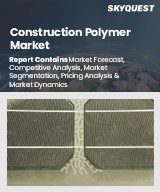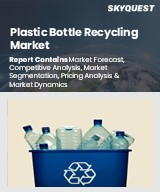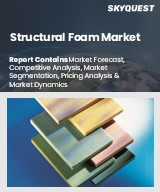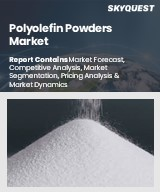
|
시장보고서
상품코드
1757042
세계의 폴리에틸렌 시장 : 유형별, 용도별, 프로세스별, 최종사용자 업계별, 지역별 - 기회 및 예측(2018-2032년)Global Polyethylene Market, By Type, By Application, By Process, By End-user Industry, By Region, Opportunities and Forecast, 2018-2032F |
||||||
세계 폴리에틸렌 시장 규모는 2025-2032년의 예측 기간 동안 4.58%의 연평균 복합 성장률(CAGR)로 2024년 1,353억 4,000만 달러에서 2032년 1,936억 5,000만 달러로 확대될 것으로 예측됩니다. 이 시장은 최근 몇 년 동안 괄목할 만한 성장세를 보였으며, 앞으로도 견조한 성장세를 유지할 것으로 예측됩니다. 세계 폴리에틸렌 시장은 다양한 최종 사용자 산업으로의 응용 및 침투로 인해 견조한 성장세를 보이고 있습니다. 폴리에틸렌 시장의 주요 촉진요인 중 하나는 플라스틱 및 포장 산업에서의 사용입니다. 또한 폴리에틸렌은 필름, 자동차 부품 및 소비재 생산에도 사용되어 세계 폴리에틸렌의 잠재력을 더욱 높이고 있습니다. 급속한 산업화와 기술 혁신이 증가함에 따라 폴리에틸렌에 직접적인 영향을 미치고 수요가 급증하는 가볍고 내구성이 뛰어난 소재에 대한 수요가 증가하고 있으며, 이는 최종 사용 산업에서 매우 중요합니다.
최근 폴리에틸렌 기술의 발전은 세계 폴리에틸렌 시장 개척을 크게 가속화하고 있습니다. 중합 공정, 촉매 및 재료 특성의 혁신으로 보다 효율적이고 내구성이 뛰어나며 다재다능한 폴리에틸렌 제품이 개발되었습니다. 이러한 기술 혁신으로 폴리에틸렌의 용도는 포장, 자동차, 건설, 의료 등 다양한 산업 분야로 확대되고 있습니다. 폴리에틸렌은 파이프라인 건설, 케이블, 단열 포장에 사용되는 재료에 광범위하게 적용되고 있으며, 포장용 건축자재 솔루션에도 적용되고 있습니다. 폴리에틸렌 제품은 오늘날의 도시 환경에서 높은 수요가 있습니다.
예를 들어, 미국 교통부 파이프라인 및 위험물 안전국은 2024년 10월, 노후화된 천연가스 파이프의 보수 및 교체에 1억 9,600만 달러를 투자할 것이라고 발표했습니다. 고밀도 폴리에틸렌 파이프를 통해 천연가스 시스템을 갱신하기 위해 640만 달러를 지원받은 플로리다 주 탤러해시(Tallahassee, Florida)를 예로 들 수 있으며, 미국 전역 20개 주에서 약 60개의 프로젝트가 진행 중입니다. 이러한 투자는 전체 인프라를 개선하고 폴리에틸렌에 대한 수요를 증가시킬 것입니다.
세계의 폴리에틸렌 시장에 대해 조사했으며, 시장 개요와 함께 유형별/용도별/공정별/최종사용자 산업별/지역별 동향, 시장 진출기업 프로파일 등의 정보를 전해드립니다.
목차
제1장 프로젝트의 범위와 정의
제2장 조사 방법
제3장 미국 관세의 영향
제4장 주요 요약
제5장 고객의 소리
제6장 세계의 폴리에틸렌 시장 전망, 2018년-2032년
- 시장 규모 분석과 예측
- 시장 점유율 분석과 예측
- 유형별
- 저밀도 폴리에틸렌
- 고밀도 폴리에틸렌
- 선형 저밀도 폴리에틸렌
- 기타
- 용도별
- 보틀 및 용기
- 필름 및 시트
- 백 및 색
- 파이프 및 피팅
- 기타
- 프로세스별
- 사출 성형
- 블로우 성형
- 압출
- 기타
- 최종사용자 업계별
- 포장
- 건설
- 자동차
- 헬스케어
- 소비재
- 기타
- 지역별
- 북미
- 유럽
- 남미
- 아시아태평양
- 중동 및 아프리카
- 기업별 시장 점유율 분석(주요 5개사 및 기타 - 금액별, 2024년)
- 유형별
- 2024년 시장 맵 분석
제7장 북미의 폴리에틸렌 시장 전망, 2018년-2032년
- 시장 규모 분석과 예측
- 시장 점유율 분석과 예측
- 국가별 시장 평가
- 미국
- 캐나다
- 멕시코
제8장 유럽의 폴리에틸렌 시장 전망, 2018년-2032년
- 독일
- 프랑스
- 이탈리아
- 영국
- 러시아
- 네덜란드
- 스페인
- 튀르키예
- 폴란드
제9장 아시아태평양의 폴리에틸렌 시장 전망, 2018년-2032년
- 인도
- 중국
- 일본
- 호주
- 베트남
- 한국
- 인도네시아
- 필리핀
제10장 남미의 폴리에틸렌 시장 전망, 2018년-2032년
- 브라질
- 아르헨티나
제11장 중동 및 아프리카의 폴리에틸렌 시장 전망, 2018년-2032년
- 사우디아라비아
- 아랍에미리트(UAE)
- 남아프리카
제12장 밸류체인 분석
제13장 Porter의 Five Forces 분석
제14장 PESTLE 분석
제15장 가격 분석
제16장 시장 역학
- 시장 성장 촉진요인
- 시장이 해결해야 할 과제
제17장 시장 동향과 발전
제18장 사례 연구
제19장 경쟁 구도
- 시장 리더 주요 5개사의 경쟁 매트릭스
- 참여 기업 주요 5개사의 SWOT 분석
- 시장 주요 기업 10개사의 상황
- ExxonMobil Corporation
- Saudi Basic Industries Corporation(SABIC)
- The Dow Chemical Company
- LyondellBasell Industries N.V.
- INEOS Group Limited
- China Petrochemical Corporation(Sinopec)
- Chevron Phillips Chemical Company LLC
- Braskem S.A.
- Borealis AG
- TotalEnergies SE
제20장 전략적 제안
제21장 회사 소개 및 면책조항
LSH 25.07.02Global polyethylene market is projected to witness a CAGR of 4.58% during the forecast period 2025-2032, growing from USD 135.34 billion in 2024 to USD 193.65 billion in 2032. The market has experienced significant growth in recent years and is expected to maintain a strong pace of expansion in the coming years. Global polyethylene market is growing at a robust rate due to its application and penetration in the various end-user industries. One of the major drivers of polyethylene market is its usage in the plastic and packaging industry. Further it is used in the production of films, automobile parts and consumer goods which is further boosting the potential of polyethylene globally. With the rise on the rapid industrialization and increasing technological innovations, it its escalating the demand of lightweight and durable materials which directly impact the polyethylene and upsurging the demand, as it is pivotal for end-use industries.
Recent developments in polyethylene technology have highly accelerated the development of the global polyethylene market. Innovations in polymerization processes, catalysts, and material properties have developed more efficient, durable, and versatile polyethylene products. These innovations have greatly expanded the application of polyethylene in a wide variety of industries such as packaging, automotive, construction, and healthcare. Polyethylene finds extensive application in pipeline building, cables, and materials used in insulation, while also being applied to packaging building material solutions. Polyethylene products are in high demand in today's urban environment.
For instance, in October 2024, the United States department of Transportation's Pipeline and Hazardous Materials Safety Administration announced an investment of USD 196 Million in repair and replacement of aging natural gas pipes. All over the United States, around 60 projects are going on across 20 states with the notable example of Tallahassee, Florida, which has received USD 6.4 Million to update its natural gas system with high-density polyethylene pipes. With these investments it will improve the overall infrastructure and will increase the demand for polyethylene.
Advancement in Polyethylene Technology is a Key Driver for the Polyethylene Market
Polyethylene technology has led to a tremendous advancement in the global polyethylene market. Recently, metallocene and single-site catalyst technologies have gained considerable attention in the production of polyethylene materials that exhibit improved tensile strength, clarity, and flexibility. All such breakthroughs have increased the spectrum of applications for polyethylene and have, therefore, impacted industries including packaging, automotive, construction, and healthcare. The new extrusion techniques along with improved resin formulations make possible the production of tougher, yet more environmentally friendly, products. Furthermore, dramatic advances in recycling technologies have resulted in high-quality recycled polyethylene, thus satisfying global efforts for sustainability and minimizing the footprint of the environment. Improved performance and cost efficiency in product output have been realized not only in the above-mentioned factors but also in consumer and industrial demands for sustainable and versatile material. This, therefore, makes the continuous innovation in polyethylene technology a key driver for the growth and expansion of the global polyethylene market, setting new standards for material performance and environmental responsibility.
For example, in March 2024, researchers at The Dow Chemical Company developed a new architecture for long chain branched polyethylene. The new technology offers greater flexibility in the use of assets and lowers the carbon footprint of large-scale manufacturing. A new catalytic mechanism was incorporated in the latest production of polyethylene; improved processing properties and reduced environmental footprint were achieved. The newly developed architecture for polyethylene now potentially becomes producible in any given reactor geometry, opening material use and waste minimization up. This is all in line with Dow's vision for resolving global challenges like climate change and plastic waste while propelling progress in the polyethylene industry toward sustainable high-performance materials.
Urbanization and Infrastructure Development Fueling the Polyethylene Market
Polyethylene is a very flexible and versatile material; hence, very important in meeting the modern demands of urban infrastructure project work. As cities grow and increase in size, the demand for high-quality, durable, and efficient materials like polyethylene will increase with time. This trend underscores the critical role polyethylene has in supporting global urbanization and infrastructure development, driving growth and innovation in the industry.
For instance, The Grand Paris Express is one of the largest urban infrastructure projects in Europe, to be built in France. It includes 200 kilometers of automated metro lines and 68 stations to improve connectivity in neglected areas around Paris. The scale of the project demands extensive use of polyethylene for durable and efficient piping, insulation, and construction materials. In another instance, opened late in 2023, the Jakarta-Bandung High-Speed Rail, part of a USD 500 billion infrastructure plan, connects cities and towns in this vast archipelago country. Such projects raise the demand for polyethylene in rail construction, electrical insulation, and urban development.
These projects reflect how urbanization stimulates the polyethylene market directly by providing opportunities in construction, transportation, and sustainable development.
High-Density Polyethylene dominate in the Global Polyethylene Market
High-Density Polyethylene is dominating the global polyethylene market. It offers high strength-to density ratio, high temperature resistance and low manufacturing cost. It is highly resistant to various types of solvent and has wide variety of applications such as bottle caps, ballistic plates, food storage containers etc. It also finds extensive application in the construction industry for pipes and fittings due to durability and resistance to environmental stress. Its lightweight but strong characteristics help the automotive industry in saving fuel. Further, technological advancements regarding recycling technologies have boosted the sustainability of high-density polyethylene. Thus, this makes it highly attractive to environmentally conscious manufacturers. All these combined factors place high-density polyethylene as one of the most popular forms of polyethylene in the global market.
In September 2024, Castrol India Limited increased its sustainability effort by recycling content in its high-density polyethylene plastic bottles to 50%. Its aim was to achieve 2,600 metric tons of recycled plastic usage in packaging by 2024.
Asia-Pacific Dominates Polyethylene Market Share
Asia-Pacific is leading in the global polyethylene market due to rapid industrialization and urbanization and due to increasing demand for polyethylene in key industries such as packaging, construction, and automobiles. China and India are some of the key countries in this region. Additional strong infrastructure development plans and sustainability initiatives in the region further enhance the wide usage of polyethylene. For instance, smart city projects and green buildings with large investments necessitate the use of polyethylene due to its durability and versatility. E-commerce, on the other hand, is booming in Asia-Pacific, thus demanding the usage of polyethylene packaging solutions to ensure safe and efficient delivery. The steady development of production technologies and recycling techniques boosts market growth opportunities further, since polyethylene is a material largely preferred for various applications. Consequently, Asia-Pacific continues to be the market leader in the region in the whole world with dynamic economic growth, industrial expansion, and focus on sustainable development practices.
For example, in November 2024, Saudi Aramco, SINOPEC, and Fujian Petrochemical Company Limited (FPCL) formed a joint venture for new integrated refining and petrochemical complex, in Fujian province, China. The integrated refining and petrochemical complex, to be in full capacity by the end of 2030, will have an oil refinery unit with 16 million tons per year capacity, 1.5 million tons per year ethylene unit capacity, 2 million tons per year paraxylene and downstream derivatives capacity. This plant reflects strategic and significant interest in the polyethylene market across Asia-Pacific, primarily driving production potential and thus ensuring demand for its chemical products increases.
Future Market Scenario (2025 - 2032F)
Advancements in recycling technologies and biodegradable polyethylene products are expected to reduce environmental impact.
Innovations in polymerization processes will enhance polyethylene properties and applications.
Asia-Pacific region continues to lead due to rapid industrialization and urbanization.
The shift towards recycling and reusing materials is driving innovation and sustainability in the market.
Key Players Landscape and Outlook
Global polyethylene market is quite competitive and dynamic in terms of the players it contains. Its leading competitors include ExxonMobil Corporation, Saudi Basic Industries Corporation (SABIC), The Dow Chemical Company, and so forth. These companies can be termed to be in excellent positions considering their large-scale productions, advanced technology, and innovations. Polyethylene is the most versatile polymer used for packaging, construction materials, automotive parts, and consumer goods, making it a core component of modern industries. These firms are now adopting sustainability, focusing on producing recyclable and bio-based polymers to address the concerns related to the environment. In addition, strategic joint ventures, capacity expansions, and embracing circular economy principles are helping in reshaping the market landscape.
For instance, in May 2024, The Dow Chemical Company and Freepoint Eco-Systems Supply & Trading LLC announced a deal for roughly 65,000 tons of pyrolysis oil annually. This oil, made from plastic waste, will be used at Dow's U.S. Gulf Coast facilities to create new, high-quality plastics, effectively building a circular economy for plastics in North America by turning waste into valuable products.
Table of Contents
1. Project Scope and Definitions
2. Research Methodology
3. Impact of U.S. Tariffs
4. Executive Summary
5. Voice of Customers
- 5.1. Factors Considered in Purchase Decisions
- 5.1.1. Cost-Effectiveness
- 5.1.2. Quality and Grade
- 5.1.3. Supply Chain Reliability
- 5.1.4. Compliance and Product Safety
6. Global Polyethylene Market Outlook, 2018-2032F
- 6.1. Market Size Analysis & Forecast
- 6.1.1. By Value
- 6.1.2. By Volume
- 6.2. Market Share Analysis & Forecast
- 6.2.1. By Type
- 6.2.1.1. Low-Density Polyethylene
- 6.2.1.2. High-Density Polyethylene
- 6.2.1.3. Linear Low-Density Polyethylene
- 6.2.1.4. Others
- 6.2.2. By Application
- 6.2.2.1. Bottles and Containers
- 6.2.2.2. Films and Sheets
- 6.2.2.3. Bags and Sacks
- 6.2.2.4. Pipes and Fittings
- 6.2.2.5. Others
- 6.2.3. By Process
- 6.2.3.1. Injection Molding
- 6.2.3.2. Blow Molding
- 6.2.3.3. Extrusion
- 6.2.3.4. Others
- 6.2.4. By End-user Industry
- 6.2.4.1. Packaging
- 6.2.4.2. Construction
- 6.2.4.3. Automotive
- 6.2.4.4. Healthcare
- 6.2.4.5. Consumer Goods
- 6.2.4.6. Others
- 6.2.5. By Region
- 6.2.5.1. North America
- 6.2.5.2. Europe
- 6.2.5.3. South America
- 6.2.5.4. Asia-Pacific
- 6.2.5.5. Middle East and Africa
- 6.2.6. By Company Market Share Analysis (Top 5 Companies and Others - By Value, 2024)
- 6.2.1. By Type
- 6.3. Market Map Analysis, 2024
- 6.3.1. By Type
- 6.3.2. By Application
- 6.3.3. By Process
- 6.3.4. By End-user Industry
- 6.3.5. By Region
7. North America Polyethylene Market Outlook, 2018-2032F*
- 7.1. Market Size Analysis & Forecast
- 7.1.1. By Value
- 7.1.2. By Volume
- 7.2. Market Share Analysis & Forecast
- 7.2.1. By Type
- 7.2.1.1. Low-Density Polyethylene
- 7.2.1.2. High-Density Polyethylene
- 7.2.1.3. Linear Low-Density Polyethylene
- 7.2.1.4. Others
- 7.2.2. By Application
- 7.2.2.1. Bottles and Containers
- 7.2.2.2. Films and Sheets
- 7.2.2.3. Bags and Sacks
- 7.2.2.4. Pipes and Fittings
- 7.2.2.5. Others
- 7.2.3. By Process
- 7.2.3.1. Injection Molding
- 7.2.3.2. Blow Molding
- 7.2.3.3. Extrusion
- 7.2.3.4. Others
- 7.2.4. By End-user Industry
- 7.2.4.1. Packaging
- 7.2.4.2. Construction
- 7.2.4.3. Automotive
- 7.2.4.4. Healthcare
- 7.2.4.5. Consumer Goods
- 7.2.4.6. Others
- 7.2.5. By Country Share
- 7.2.5.1. United States
- 7.2.5.2. Canada
- 7.2.5.3. Mexico
- 7.2.1. By Type
- 7.3. Country Market Assessment
- 7.3.1. United States Polyethylene Market Outlook, 2018-2032F*
- 7.3.1.1. Market Size Analysis & Forecast
- 7.3.1.1.1. By Value
- 7.3.1.1.2. By Volume
- 7.3.1.2. Market Share Analysis & Forecast
- 7.3.1.2.1. By Type
- 7.3.1.2.1.1. Low-Density Polyethylene
- 7.3.1.2.1.2. High-Density Polyethylene
- 7.3.1.2.1.3. Linear Low-Density Polyethylene
- 7.3.1.2.1.4. Others
- 7.3.1.2.2. By Application
- 7.3.1.2.2.1. Bottles and Containers
- 7.3.1.2.2.2. Films and Sheets
- 7.3.1.2.2.3. Bags and Sacks
- 7.3.1.2.2.4. Pipes and Fittings
- 7.3.1.2.2.5. Others
- 7.3.1.2.3. By Process
- 7.3.1.2.3.1. Injection Molding
- 7.3.1.2.3.2. Blow Molding
- 7.3.1.2.3.3. Extrusion
- 7.3.1.2.3.4. Others
- 7.3.1.2.4. By End-user Industry
- 7.3.1.2.4.1. Packaging
- 7.3.1.2.4.2. Construction
- 7.3.1.2.4.3. Automotive
- 7.3.1.2.4.4. Healthcare
- 7.3.1.2.4.5. Consumer Goods
- 7.3.1.2.4.6. Others
- 7.3.1.2.1. By Type
- 7.3.1.1. Market Size Analysis & Forecast
- 7.3.2. Canada
- 7.3.3. Mexico
- 7.3.1. United States Polyethylene Market Outlook, 2018-2032F*
All segments will be provided for all regions and countries covered
8. Europe Polyethylene Market Outlook, 2018-2032F
- 8.1. Germany
- 8.2. France
- 8.3. Italy
- 8.4. United Kingdom
- 8.5. Russia
- 8.6. Netherlands
- 8.7. Spain
- 8.8. Turkey
- 8.9. Poland
9. Asia-Pacific Polyethylene Market Outlook, 2018-2032F
- 9.1. India
- 9.2. China
- 9.3. Japan
- 9.4. Australia
- 9.5. Vietnam
- 9.6. South Korea
- 9.7. Indonesia
- 9.8. Philippines
10. South America Polyethylene Market Outlook, 2018-2032F
- 10.1. Brazil
- 10.2. Argentina
11. Middle East and Africa Polyethylene Market Outlook, 2018-2032F
- 11.1. Saudi Arabia
- 11.2. UAE
- 11.3. South Africa
12. Value Chain Analysis
13. Porter's Five Forces Analysis
14. PESTLE Analysis
15. Pricing Analysis
16. Market Dynamics
- 16.1. Market Drivers
- 16.2. Market Challenges
17. Market Trends and Developments
18. Case Studies
19. Competitive Landscape
- 19.1. Competition Matrix of Top 5 Market Leaders
- 19.2. SWOT Analysis for Top 5 Players
- 19.3. Key Players Landscape for Top 10 Market Players
- 19.3.1. ExxonMobil Corporation
- 19.3.1.1. Company Details
- 19.3.1.2. Key Management Personnel
- 19.3.1.3. Products and Services
- 19.3.1.4. Financials (As Reported)
- 19.3.1.5. Key Market Focus and Geographical Presence
- 19.3.1.6. Recent Developments/Collaborations/Partnerships/Mergers and Acquisition
- 19.3.2. Saudi Basic Industries Corporation (SABIC)
- 19.3.3. The Dow Chemical Company
- 19.3.4. LyondellBasell Industries N.V.
- 19.3.5. INEOS Group Limited
- 19.3.6. China Petrochemical Corporation (Sinopec)
- 19.3.7. Chevron Phillips Chemical Company LLC
- 19.3.8. Braskem S.A.
- 19.3.9. Borealis AG
- 19.3.10. TotalEnergies SE
- 19.3.1. ExxonMobil Corporation
Companies mentioned above DO NOT hold any order as per market share and can be changed as per information available during research work.



















